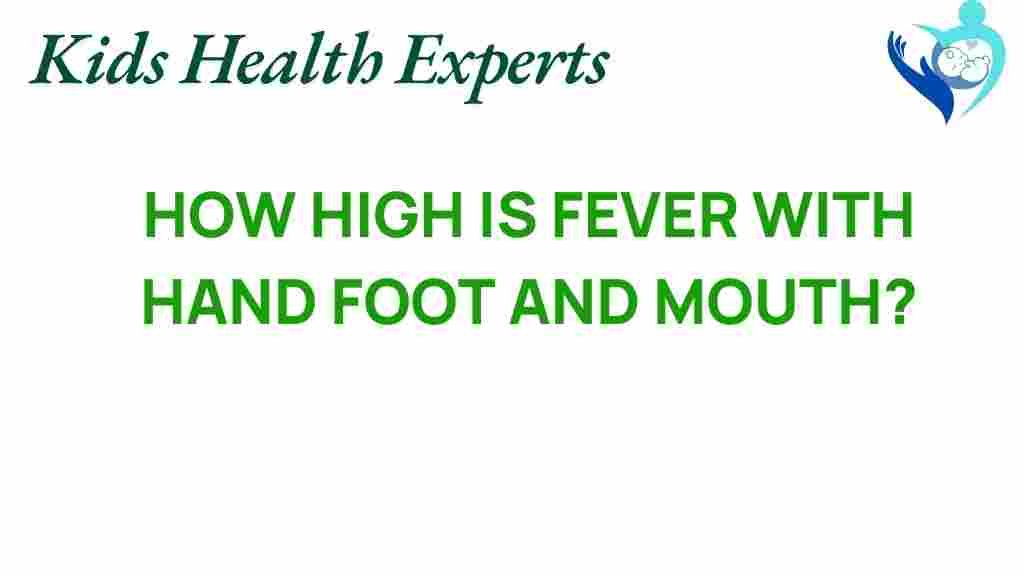Understanding Fever: How High Can It Go with Hand, Foot, and Mouth Disease?
Fever is a common symptom that often accompanies various illnesses, particularly in children. One such illness is Hand, Foot, and Mouth Disease (HFMD), a viral infection that primarily affects infants and children. Understanding the relationship between fever and HFMD is crucial for parents and caregivers in managing children’s health effectively.
This article delves into the symptoms of HFMD, how fever manifests in this condition, and provides guidance on treatment and fever management. By understanding these aspects, parents can better navigate the challenges that come with this viral infection.
What is Hand, Foot, and Mouth Disease?
Hand, Foot, and Mouth Disease is a viral infection typically caused by coxsackievirus. It spreads easily, especially among young children, making it a common childhood illness. The disease is characterized by:
- Fever
- Rash or sores on the hands and feet
- Ulcers in the mouth
- General malaise
HFMD is usually mild and self-limiting, but it can be uncomfortable for children and concerning for parents. Understanding the symptoms can help in early detection and management.
Symptoms of Hand, Foot, and Mouth Disease
The symptoms of HFMD often appear three to six days after exposure to the virus. Parents should monitor their children for the following key symptoms:
- Fever: This is often the first symptom and can vary from mild to high.
- Sore throat: Children may complain about pain when swallowing.
- Ulcers: Painful sores develop in the mouth, which can make eating and drinking difficult.
- Rash: A rash may appear on the hands, feet, and sometimes the buttocks.
- Irritability: Young children may become more fussy and irritable due to discomfort.
How High Can Fever Go with Hand, Foot, and Mouth Disease?
Fever associated with HFMD can range from mild (around 100°F or 37.8°C) to high (up to 104°F or 40°C). While a high fever can be concerning, it’s important to remember that fever is a natural response of the body to fight off viral infections.
In most cases, the fever lasts for about 3 to 5 days. However, if the fever persists beyond this period or reaches dangerously high levels, it is advisable to seek medical attention.
Fever Management in Children
Managing fever during Hand, Foot, and Mouth Disease is essential for ensuring your child’s comfort. Here are some effective strategies:
- Hydration: Encourage your child to drink plenty of fluids to prevent dehydration, especially if they have mouth sores.
- Rest: Ensure your child gets ample rest to help their body recover from the illness.
- Medications: Over-the-counter medications such as acetaminophen or ibuprofen can help reduce fever and alleviate discomfort. Always consult your pediatrician before administering any medication.
- Cool baths: A lukewarm bath can help lower body temperature and provide comfort.
Troubleshooting Tips for Fever Management
Sometimes, managing fever in children can be challenging. Here are some troubleshooting tips to consider:
When to Seek Medical Attention
It is crucial to know when to consult a healthcare professional. Seek medical attention if your child:
- Has a fever higher than 104°F (40°C)
- Shows signs of dehydration (dry mouth, no tears, decreased urination)
- Is excessively lethargic or difficult to awaken
- Complains of severe headache or neck stiffness
- Has a persistent fever lasting more than 5 days
Home Care Tips
In addition to the fever management strategies mentioned earlier, here are a few home care tips:
- Comfortable clothing: Dress your child in light clothing to help regulate their body temperature.
- Cool compresses: Applying a cool, damp washcloth to your child’s forehead can provide relief.
- Monitor symptoms: Keep a close eye on your child’s symptoms and note any changes.
Understanding the Illness Progression
Hand, Foot, and Mouth Disease typically progresses through several stages:
- Incubation period: 3 to 6 days after exposure, when the child is asymptomatic.
- Onset of fever and malaise: The child may feel unwell and develop a fever.
- Development of sores: Ulcers appear in the mouth, followed by a rash on the hands and feet.
- Recovery: Symptoms usually resolve within 7 to 10 days.
During recovery, it’s essential to continue monitoring your child and manage any residual symptoms, such as fever or irritability.
Conclusion
Understanding fever in the context of Hand, Foot, and Mouth Disease is vital for parents and caregivers. While fever is a natural part of the body’s response to viral infections, managing it effectively can significantly improve a child’s comfort and overall health. By recognizing the symptoms of HFMD and knowing when to seek medical assistance, parents can navigate this illness with confidence.
For more information on children’s health and illness management, you can visit CDC’s Hand, Foot, and Mouth Disease page. For further reading on fever management, check out this resource.
Remember, always consult with your pediatrician for personalized advice and treatment options tailored to your child’s specific health needs.
This article is in the category Conditions and created by KidsHealthExperts Team
